| Back Number | No.21 2005/08/03 | |||
| News | In Prayer of World Peace |  |
||
| Pavilions | Indonesia Pavilion (Global Common 6) Australian Pavilion (Global Common 6) Singapore Pavilion (Global Common 6) Thailand Pavilion (Global Common 6) |
|||
| Column | EXPO 2005 by Night | |||
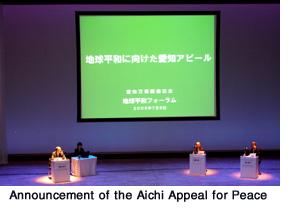 The Forum for a Peaceful Earth (Sponsored by the Aichi Forum for a Peaceful Earth; Co-sponsored by the Japan Association for the 2005 World Exposition) was held on July 9 at EXPO Hall. The theme was “Mission for Humanity to Continue on Earth in the 21st Century.” The Aichi Appeal for Peace - Peace on Earth through Expo 2005 Aichi, Japan - a message of peace for humanity of the 21st century drafted by five global intellectual leaders with Sadako Ogata, President of the Japan International Cooperation Agency (JICA) and former UN High Commissioner for Refugees as their representative, was announced at the forum.
The Forum for a Peaceful Earth (Sponsored by the Aichi Forum for a Peaceful Earth; Co-sponsored by the Japan Association for the 2005 World Exposition) was held on July 9 at EXPO Hall. The theme was “Mission for Humanity to Continue on Earth in the 21st Century.” The Aichi Appeal for Peace - Peace on Earth through Expo 2005 Aichi, Japan - a message of peace for humanity of the 21st century drafted by five global intellectual leaders with Sadako Ogata, President of the Japan International Cooperation Agency (JICA) and former UN High Commissioner for Refugees as their representative, was announced at the forum.The Aichi Appeal for Peace maintained that the first condition for preserving the environment and resources for future generations, resolving today’s problems of poverty and enabling humanity to live secure lives that are worthy of respect as humans is the realization of peace. It appealed the necessity for people around the world to begin by going beyond differences in values and cultural backgrounds to understand and respect each other, making compromises, and thinking as a fellow human being from the standpoint of others in order to realize peace on Earth rather than be in conflict. In his message, Nobuo Kato, Representative of the Aichi Forum for a Peaceful Earth which sponsored the forum, referred to the terrorist attacks which occurred in London last month and expressed his hope that in this unprecedented time of confusion in the history of humankind, the Aichi Appeal for Peace will reach every corner of the world and lead the widening of the circle of people’s courageous action. Additional events in prayer for world peace include a concert to be held on August 6 in Hiroshima Prefecture. With the theme of “What each one of us can do today,” the concert is produced by Kosetsu Minami, a well-known Japanese folk musician. The concert hall and the EXPO 2005 Aichi, Japan venue will be linked via television, and the concert is scheduled to be broadcast live at EXPO Plaza. The splendor of peace will be communicated to the world by sharing this concert and its spirit of peace at EXPO 2005. |
![]()
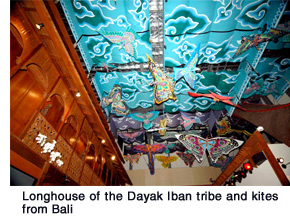 Over 300 tribes live in the Republic of Indonesia, a country consisting of more than 17,000 islands. Each island and tribe has developed a unique and colorful array of cultures. The theme of the Indonesia pavilion is “People and Nature in Harmony.” The pavilion introduces the nature, flora and fauna typical of the tropics, the distinctive culture and arts of Indonesia’s regions, and so on.
Over 300 tribes live in the Republic of Indonesia, a country consisting of more than 17,000 islands. Each island and tribe has developed a unique and colorful array of cultures. The theme of the Indonesia pavilion is “People and Nature in Harmony.” The pavilion introduces the nature, flora and fauna typical of the tropics, the distinctive culture and arts of Indonesia’s regions, and so on.Upon entering the pavilion, visitors will find themselves in the exotic atmosphere of the Biodiversity Corridor where real tropical plants have been brought to recreate a jungle. Beyond this corridor is the main exhibition space. This is a space where the culture and arts of Indonesia’s diversity of tribes are gathered. A longhouse of the Dayak Iban tribe of Kalimantan, featured by beautifully detailed woodcarvings, has been recreated as the backdrop of a stage. A 15-minute performance of the traditional dances of various regions in Indonesia is usually held three times a day here, from noon, 2:00pm and 4:00pm. From the ceiling hang colorful Balinese kites in the shape of birds, butterflies, dragonflies and other motif that look as if they are ready to fly high into the sky. A structure built in the likeness of a rice barn of the Toraja tribe of Sulawesi, with a characteristically curving roof sweeping at both ends like a bull horn, is used as the information corner of the Indonesia Pavilion. Indonesia’s National Day is August 17, which is the 60th anniversary of the republic’s independence. It should provide a perfect opportunity to feel Indonesia’s diverse culture up close. |
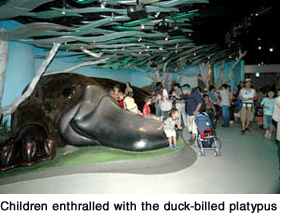 The duck-billed platypus is a unique yet cute animal with a broad bill and webbed feet. They have been in existence for 65,000 years. Found only in Australia, they lay eggs and are the most primitive of mammals in existence today.
The duck-billed platypus is a unique yet cute animal with a broad bill and webbed feet. They have been in existence for 65,000 years. Found only in Australia, they lay eggs and are the most primitive of mammals in existence today.The Australian Pavilion chose the platypus to represent its theme, which is “We have to protect and preserve our environment for future generations.” In other words, the pavilion speaks of protecting this mammal for a further 65,000 years into the future. This shows a decision to pass the beautiful natural environment of Australia’s rivers, lakes and swamps as they are onto future generations. There is a giant 12-meter model of the platypus on display at a room in the pavilion. It is a breathtaking sight for visitors to the pavilion who enter this room, and children run forward in joy to hug this model. Parents line their children up in front of the model of the platypus to take commemorative photographs, while children continue to be mesmerized by footage of this animal shown on a screen while they continue to hug the model. The video transmits a message regarding the importance of preserving the beautiful natural environment in which the platypus lives. At the same time this pavilion introduces, through beautifully artistic footage utilizing state-of-the-art technology, the wisdom for coexisting with nature possessed since ages past by the Aborigine people native to this country, the necessity to pass this wisdom on, as well as Australia as it is today created as a result of the immigration and integration of various ethnic groups to this continent. The attendants at the Australian Pavilion were chosen from among 3,000 applicants. They are cheerful pavilion guides who can provide visitors with information in Japanese as well as English. We hope that visitors will enjoy their visit this pavilion. |
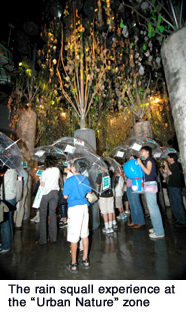 Singapore is not just a country of skyscrapers - it is a city-in-a-garden where such structures are surrounded by parks and gardens. Because of limited size of the national territory, it is true that many people live in high rises. However, there is greenery planted not only in parks but also within and atop each and every building. The lush greenery now found in Singapore is that created by people.
Singapore is not just a country of skyscrapers - it is a city-in-a-garden where such structures are surrounded by parks and gardens. Because of limited size of the national territory, it is true that many people live in high rises. However, there is greenery planted not only in parks but also within and atop each and every building. The lush greenery now found in Singapore is that created by people.A zone at the Singapore Pavilion where visitors will experience a day in the life of Singapore is the Urban Nature zone. A screen on a wall shows, in fast motion, a day of the lives of Singaporeans, from people doing Tai Chi in the morning mist to the nightscape of high rises in the city. While visitors are engrossed in the realism of the footage depicting people's daily lives, they begin to hear thunder in the distance. A squall dumping 17 liters of water per second suddenly begins to rain upon visitors and they will find puddles beneath their feet. It is a surprising 30-second experience, but not to worry; visitors are handed an umbrella at the entrance so there is no fear of becoming drenched. Singapore is celebrating the 40th anniversary of its independence this year. Singapore is a multiethnic nation in which its people, including those of Malayan, Chinese and Indian descent, joined hands to achieve the republic’s independence. In fact, the theme of the Singapore Pavilion is “World without Walls.” It is a celebration of the country that has no barriers and accepts people of various ethnic groups and religions. It also contains the wish to be accepted by all people. The Singapore National Day on August 9 coincides with the country’s Independence Day. A visit to this national day at EXPO 2005 Aichi, Japan will provide visitors an opportunity to come into contact with Singapore, a unique and multiethnic nation. |
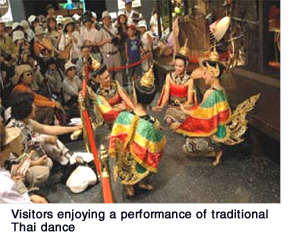 The theme of the Thailand Pavilion is “River of Wisdom.” Thais have held a special respect and appreciation for the gift of water and fertile land provided by the great Chao Phaya River that flows north to south in the Kingdom of Thailand.
The theme of the Thailand Pavilion is “River of Wisdom.” Thais have held a special respect and appreciation for the gift of water and fertile land provided by the great Chao Phaya River that flows north to south in the Kingdom of Thailand.The attention of visitors to the Thailand Pavilion will first be caught by the beautiful depictions of the colors of the Chao Phaya River at dusk and the scenery of a Buddhist temple on the pavilion exterior. Inside, they will find six zones representing the harmony between the people of Thailand and water, such as the “River of Wealth,” which portrays through displays, like a Thai house and fishing gear, the daily lives of the people that live along waterways, and the “River of Culture” that recreates the waterfront scenery of Thailand through an exhibit of small boats filled with vegetables and models of the splendorous boats of the Royal Barge Procession. At the “River of Friendship” zone, there are daily performances of traditional Thai dances of which there are more than 60 different types, including classical Thai dance, modern Thai dance and Thai folk dances. The graceful dancing and the gentle and beautiful expressions on the faces of performers clad in lustrous ethnic costumes will provide a full experience of the attractiveness of Thailand, also known as the country of smiles. The “Kitchen of the World” zone at the pavilion enables a taste of Thai cuisine, including spicy dishes seasoned with various herbs, frozen mango and coconut juice. August 12, H.M. Queen Sirikit’s Birthday, is one of the most important days in Thailand, and has been selected to be Thailand's National Day at EXPO 2005 Aichi, Japan. The celebration at EXPO 2005 will include a performance of a traditional Thai puppet show and contemporary Thai dance. |
![]()
|
EXPO 2005 Aichi, Japan is recording attendance that goes beyond original expectations, and the number of visitors coming to the EXPO from the late afternoon is now also on the increase. With summer in full swing, daylight now lasts until past 7:00pm, and the cool night air provides a comfortable setting for walking around the EXPO 2005 venue. But another reason for increased night-time attendance is the appeal that the EXPO itself has for visitors at night. |
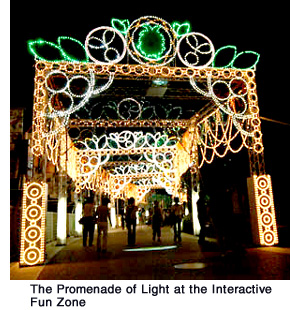 Many pavilions are brilliantly lit up in the evenings, showing flavor that differs from during the day, and they are almost all filled with people until pavilion closing hours (9:00pm in the Nagakute Area). The early-evening to night-time events taking place daily, such as those at EXPO Plaza including The Forest Fairy's Ball where visitors can enjoy a parade and dances by fairies and sprites; the Twilight Concert, which can be freely viewed from the plaza’s grassy area and creates a soothing atmosphere through the collaboration of various people and music; and the Bio Symphony - Kan (Cycle), a magical show consisting of footage, music, mist and light at the Bio-lung that is imaged after life’s breath; as well as In the Evening at Koi Pond, a beautiful, beguiling dream dramatized with water and light, are all proving popular.
Many pavilions are brilliantly lit up in the evenings, showing flavor that differs from during the day, and they are almost all filled with people until pavilion closing hours (9:00pm in the Nagakute Area). The early-evening to night-time events taking place daily, such as those at EXPO Plaza including The Forest Fairy's Ball where visitors can enjoy a parade and dances by fairies and sprites; the Twilight Concert, which can be freely viewed from the plaza’s grassy area and creates a soothing atmosphere through the collaboration of various people and music; and the Bio Symphony - Kan (Cycle), a magical show consisting of footage, music, mist and light at the Bio-lung that is imaged after life’s breath; as well as In the Evening at Koi Pond, a beautiful, beguiling dream dramatized with water and light, are all proving popular.A recent night-plan addition further increases the appeal of EXPO 2005 in the evening. First, the Promenade of Light has been set up in the walkway of the Interactive Fun Zone. The promenade begins with a 6-meter-high Gate of Light decorated with Kiccoro, and a production of light which casts an image of Kiccoro that moves around on the ground and invite visitors into the Interactive Fun Zone. |
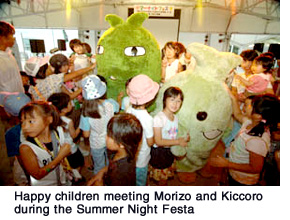 After passing through the Promenade of Light, visitors will see a circular plaza with 4-meter-high Morizo and Kiccoro balloons lit up to greet visitors. The Summer Night Festa is held at this plaza every Friday, Saturday and Sunday from the early evening, until September 11.
After passing through the Promenade of Light, visitors will see a circular plaza with 4-meter-high Morizo and Kiccoro balloons lit up to greet visitors. The Summer Night Festa is held at this plaza every Friday, Saturday and Sunday from the early evening, until September 11.The festa begins with a visit to the plaza by Morizo and Kiccoro, the official mascots of EXPO 2005. This is the only place at the EXPO 2005 where visitors will be able to meet the pair at the given time and take pictures with them. This is a major appeal for families with children visiting the EXPO. (Please note that this event may be cancelled in the case of rain.) At around 7:30pm, the circular plaza becomes a live performance setting for adults. Friday night is “Club Night,” a collaboration of DJ and dancers. Saturdays is “Mixture Night.” It is a multinational, multi-genre performance that at times also sees the participation of musicians appearing at the pavilions of overseas countries. Finally, Sundays is “Jazz & Bossa Nova Night.” Acoustic tunes fill the night air and transform the plaza into a space for adults. Visitors on a date at EXPO 2005 may enjoy first taking a stroll through the Promenade of Light, seeing the live performance at the circular plaza, and then taking a ride on the Ferris wheel located nearby for a beautiful panoramic view of the EXPO 2005 venue by night. Why not utilize the Evening Discount Admission Ticket (2,300 yen for adults, 1,300 yen for juniors, 800 yen for children, and 1,900 yen for seniors) for visitors entering the park from 5:00pm onwards and enjoy an appealing summer evening like this at EXPO 2005 Aichi, Japan? |
| EXPO 2005 AICHI, JAPAN Newsletter | |
| To read past issues:Back Number | |
| Editor/Publisher: Japan Association for
the 2005 World Exposition Head Office: 1533-1 Ibaragabasama, Nagakute-cho Aichi 480-1101 Japan Nagoya Office: Nagoya Daiya II Bldg 4F, 3-15-1 Meieki Nakamura-ku, Nagoya, Aichi 450-0002 Japan Tokyo Office: Iino Bldg 8F, 2-1-1 Uchisaiwai-cho Chiyoda-ku, Tokyo 100-0011 Japan |
 |
© Japan Association for the 2005 World Exposition
